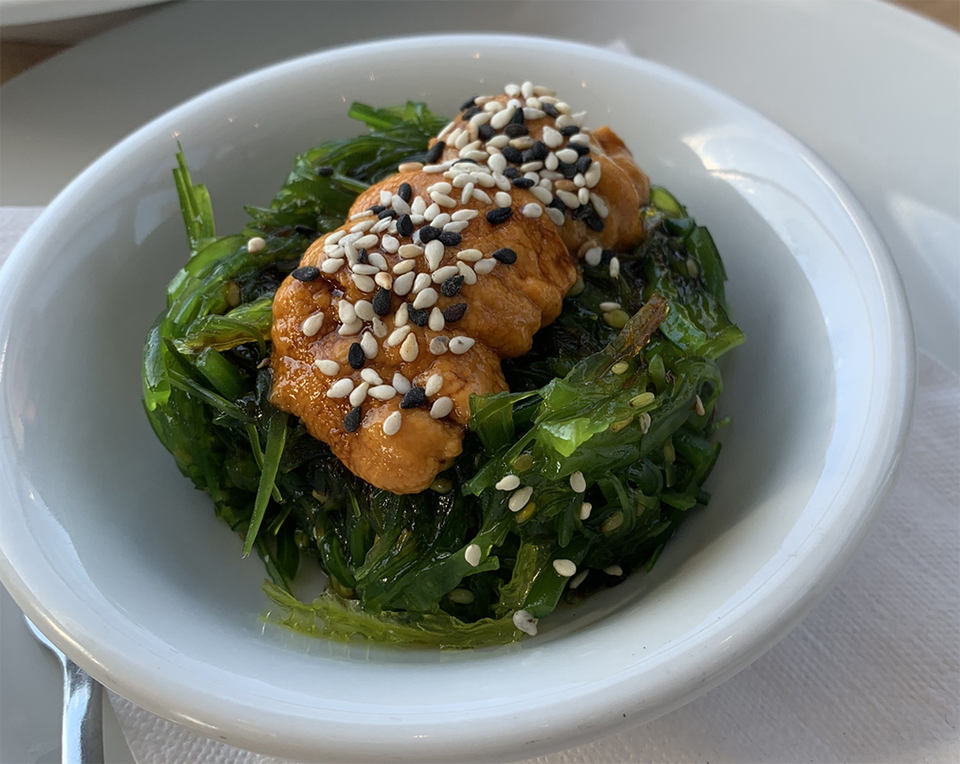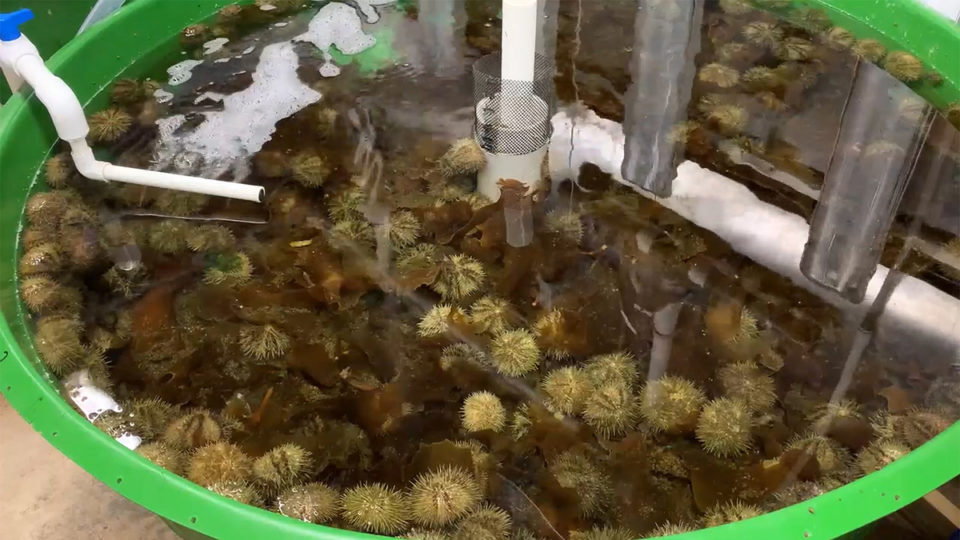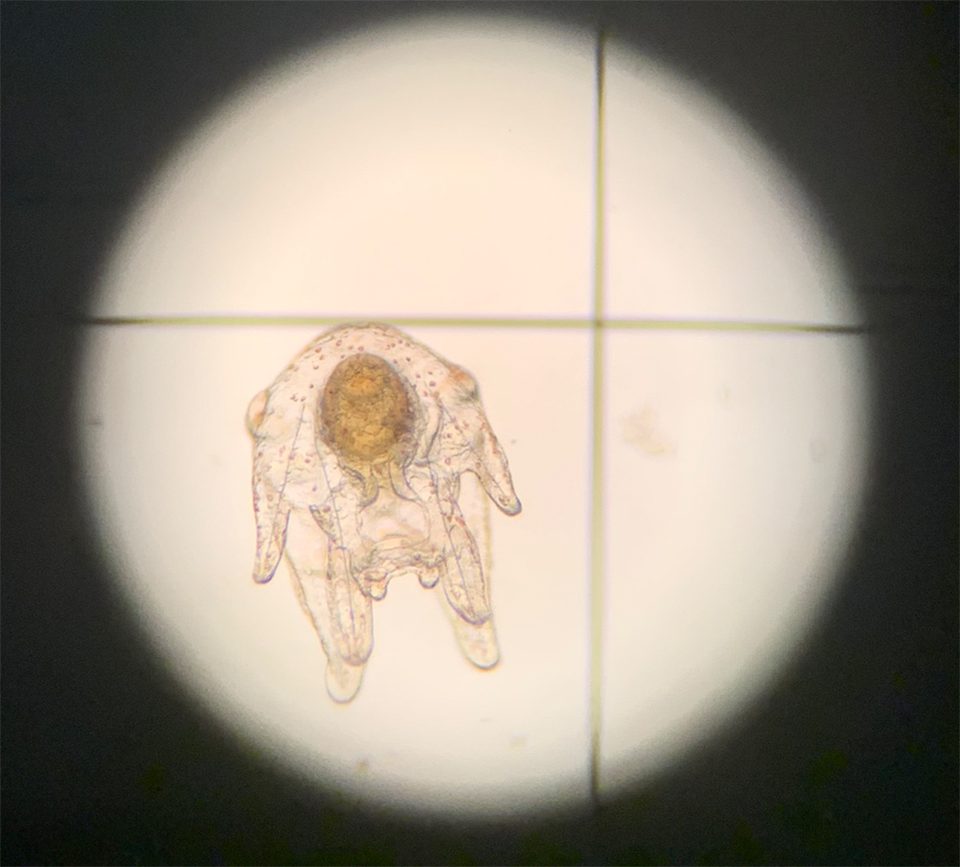With more than one way to farm green sea urchins, interest in developing a source for the sushi delicacy uni is on the rise

In an effort to both restore waterways and meet a growing demand for the so-called foie gras of the sea, researchers in the northeastern corner of the United States are stepping up their efforts to restore green sea urchins.
“There is a demand in the market for urchin roe, or uni, but there really isn’t the supply to meet it in New England,” said Coleen Suckling, assistant professor of sustainable aquaculture at the University of Rhode Island. “There is space to work towards this demand in New England but it needs to be through sustainable aquaculture.”
Researchers from the University of Maine, Maine Sea Grant, University of Rhode Island and University of New Hampshire have received a $100,000 grant from the U.S. Department of Agriculture Northeast Regional Aquaculture Center to start moving toward that goal. The grant will be used to improve hatchery production and work with potential urchin farmers on grow-out possibilities in the Gulf of Maine and coastal northern New England.
If they’re successful, they can set the template for creating a sustainable farmed source of uni, ready to be exported around the world as the market, especially in Asia, continues to grow.

Why sea urchins in New England?
Green sea urchins were once as common in New England waters as Vineyard Vines swim trunks on a hot summer day. In 1995, Maine’s sea urchin harvest, which was mostly wild, was 34 million pounds and worth $35.6 million, according to the Maine Department of Marine Resources. In 2019, it had dropped to 1.7 million pounds worth $5.8 million.
Blame the usual suspects: fishing pressure and “a phase shift in the bottom where the new ecotype was less hospitable to settling urchin larvae,” said Dana Morse of the Maine Sea Grant Marine Extension Team. Heavy seaweed gave predators cover “so even if an urchin larva does settle out and attaches to something, there are a lot of hungry things looking to munch on a small urchin.”
Sea urchins are herbivores that in the northwest Atlantic Ocean primarily eat seaweed and algae, which is why researchers also see them as part of an overall effort to clean up New England’s exploited ecosystems.
They are also able to survive in a more alkaline waters, as oceans are becoming as they absorb more carbon dioxide from the atmosphere, said Suckling.
“Urchins have been shown to cope well with climate change. They can grow even bigger edible uni (gonads) in those conditions,” she said. “They are fairly resilient.”
The uni market
There’s also an exploding demand for uni, which are the sea urchin gonads, the only edible part of the animal. The biggest market for uni been in Japan, which takes 80 to 90 percent of the international global supply, according to Matis Iceland. But the interest in uni is growing, especially in China.
“If that remotely starts to grow, as it has with every seafood market in China, it has potential to take off,” said Brian Tsuyoshi Takeda, founder and CEO of Urchinomics, which ranches zombie urchins to fatten them up and then sell the roe. “We’re on the cusp of that.”
https://www.aquaculturealliance.org/advocate/ranching-enhancing-zombie-urchins-kelp-forests/
He believes that uni could follow the same pattern as that of abalone: a once rare item that because of aquaculture is now more common but still draws a high price. “Then the 70,000-ton industry could become a 700,000-ton industry,” he said.
While urchins have become rare in New England waterways compared to what they were in the 1990s, they are invasive pests in other parts of the world. In California, for example, sea otters had been a sea urchins’ natural predators. When sea otter populations declined, sea urchins multiplied, and then destroyed kelp forests to leave barrens behind. Projects like Urchinomics and AquaVitae are looking to collect those empty urchins for the sake of letting kelp forests grow back, but also to feed them to create sellable roe, a growing process that takes six to 12 weeks compared to the two to three years it takes in a hatchery.
While Tsuyoshi Takeda is obviously invested in creating more roe in the Urchinomics way, he said the project in New England is also part of the future of a sustainable farmed sea urchin crop, especially when “that biomass of empty urchins has been depleted and all the kelp forests are back.”

Addressing bottlenecks and hesitation
Suckling said the New England team is using the grant to address “bottlenecks,” in the sea urchin farming process, including that seed “it is quite expensive and not competitive” compared to something like oysters, she said. “We still need to further optimize the methods in hatchery reproduction.”
Another prong is finding partners for the project, and convincing younger fishers that sea urchins were once normal there.
“A lot of people in the industry who haven’t seen the previous market in New England probably don’t see it as an option,” she said of replenishing the sea urchin population. “We’re working on increasing the awareness of the ability to grow sea urchins as something to consider in aquaculture.”
Suckling, in collaboration with Steve Eddy and Luz Kogson of the University of Maine’s Center of Cooperative Aquaculture Research, has been running a series of talks and workshops to educating potential partners, and also being a free advice resource. The group also plans to “provide free seed for people to try out sea urchin growth, and see if they would like to take it further,” she said. They hope to have their first seed ready by this fall and are building an email list for those who are interested.
Editor’s note: For more information, aquaculturists can contact Suckling at coleensuckling@uri.edu or Luz Kogson at luz.kogson@maine.edu.
Follow the Advocate on Twitter @GAA_Advocate
Now that you've finished reading the article ...
… we hope you’ll consider supporting our mission to document the evolution of the global aquaculture industry and share our vast network of contributors’ expansive knowledge every week.
By becoming a Global Seafood Alliance member, you’re ensuring that all of the pre-competitive work we do through member benefits, resources and events can continue. Individual membership costs just $50 a year. GSA individual and corporate members receive complimentary access to a series of GOAL virtual events beginning in April. Join now.
Not a GSA member? Join us.
Author
-

Jen A. Miller
Jen A. Miller is a New Jersey-based writer whose work has appeared in everything from The New York Times to Engineering News Record.
Tagged With
Related Posts

Responsibility
Can shellfish growers cash in with nutrient trading?
In Maryland and Virginia, developers can buy credits from oyster farmers to offset their assumed environmental impacts. Can "nutrient trading" work?

Responsibility
In Delaware Bay, a delicate balancing act for shellfish farms
Oyster producers learn to adapt in a Delaware Bay ecosystem that's critical for endangered shorebirds and highly protected horseshoe crabs.

Innovation & Investment
Little fish in a big pond: Minnowtech aims to give fresh vision to shrimp inventory
Because shrimp farmers lack accurate in-pond inventory, startup Minnowtech is on the verge of offering a data-driven solution. It’s got something to do with jellyfish.

Responsibility
Ocean Rainforest foresees a bright future for ocean plants, and not just in Asia
Faroe Islands company believes nutritious and fast-growing seaweed is a versatile raw material and the oceans’ best defense against climate change.

